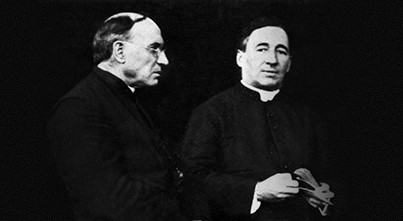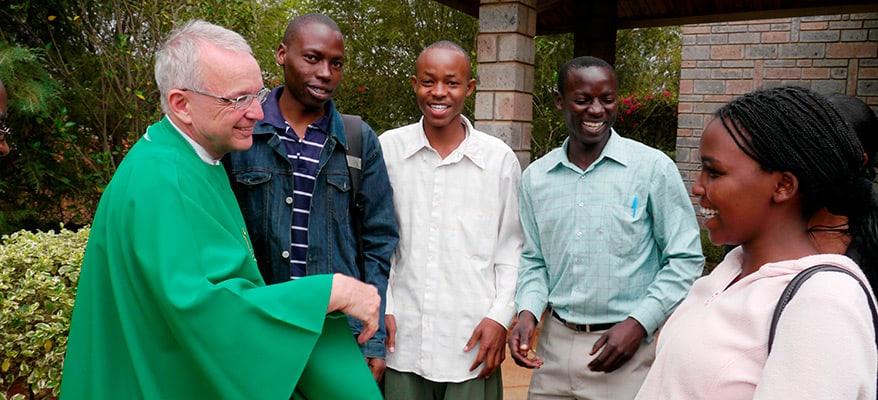Stories of Mission
Feeding on Living Bread Journey of Faith
Corpus Christi Our feast today is Corpus Christi, the Body of Christ; more formally, it is termed: The Most Holy Body and Blood of Christ. Today’s Gospel is drawn from chapter six of John’s Gospel, often termed the “bread of life” chapter. Here Jesus declares: “I am...
David Steindl-Rast, with Robert Ellsberg
The magnum opus of our most important living Catholic author—a pioneer in the Christian contemplative life and spiritual writing. Unlike any book he’s written before, Brother David Steindl-Rast offers spiritual direction from a unique perspective in history. At 96...
Julian’s Gospel, with Veronica Mary Rolf
Veronica Mary Rolf is an independent scholar of medieval studies and comparative literature, educated at Columbia University. She has spent her life in the professional theatre, as a playwright, performer, and artistic director.
Living into God’s Mystery, Journey of Faith
Today is Trinity Sunday; it comes just one week after the beautiful feast of Pentecost that celebrates the dynamic presence of the Holy Spirit in the Church and in the entire world. Our “Trinitarian” Christian faith asserts that there is one God who is three distinct...
Pentecost Continues Today, Journey of Faith
On this beautiful feast of Pentecost, we affirm that the Holy Spirit is alive in the Church. Diverse Spirit-given gifts flourish in Christian communities across the globe. Today we Catholics are privileged to live in a renewed Church, in a unique age of “a new...
Mission: Keeping Jesus’ Memory Alive, Journey of Faith
As we celebrate the feast of the Ascension today, we are reminded that the task of Christians is to preserve the dynamic, enriching, and salvific memory of Jesus. Mission permeates the entire New Testament; some important mission texts are simply listed here: Matthew...
A Truly Special Anniversary, Journey of Faith
Today’s Scripture readings all speak of God’s continuing and abiding presence with us. The first reading narrates how God remains with the people of Samaria as they receive the Holy Spirit. Next, the Apostle Peter speaks of Christ’s presence in people’s hearts. In...
A Truly Special Anniversary, Journey of Faith
In today’s Gospel we hear Jesus saying: “I have come so that they may have life and have it to the full” (Jn 10:10). Reflecting on this passage about the “fullness of life,” I am reminded of a special anniversary the Church is celebrating this year: the 150th...
Our Journey to Emmaus, Journey of Faith
The narrative from Luke’s Gospel of the journey of two disciples to Emmaus is well known and loved (Lk 24:13-35). We can imagine the scene: two men are walking; they are dejected, sad, and overwhelmed by recent events. Jesus, their dear friend and presumed messiah,...
An “Easter Candle” Story, Journey of Faith
With deep faith and courageous hope, Saint Maximilian Kolbe endured the extreme horrors of Auschwitz, the notorious Nazi concentration camp in Poland. He proved that self-giving love and compassion can thrive even in extreme darkness and cruelty. His heroic life...
Easter Encounters, Journey of Faith
Allow me to tell you about a unique celebration of Easter from the Philippines, where I happily served as a missionary for over five decades. Filipinos celebrate a ritual, known locally as the “meeting” (encuentro); it dramatizes the encounter of the risen Lord and...
Former Superior General, Fr. John Sivalon Once Described God’s Mission This Way
A tangle of twigs lies drying in the sun, And then a spark catches one, and she, Astonished by divinity, topples and tumbles and ignites Another and another and another and Soon the whole tangle is aflame Gibber jabbering in many tongues! Chattering and blabbering...
Maryknoll: Looking For Dreamers And Visionaries by Fr. Mike Snyder
The missionary life takes us to so many cool places in the world! I took this photo from a plane while flying from Nairobi, Kenya to Dar es Salaam, Tanzania and I have shared it in several newsletters. It was a very clear day. Having spent many years serving...
Our Fruit Orchard Maryknoll Initial Formation House By Sem. Joshua Mutende Maondo
Jesus turned and saw them following him and said to them, “What are you looking for?” They said to him, “Rabbi” (which translated means Teacher), “where are you staying?” He said to them, “Come, and you will see.” So, they went and saw where he was staying, and they...
Night of Reflection with Young Adults By Fr. Rodrigo Ulloa
The prophet Hosea was commissioned by God to preach to the Israelites because they their faith, disconnected from God, were separated from the covenant and were lost on their own accord. There is a liturgical song that is titled, Hosea which ponders on the meaning of...
Senior Missioner Fr. Dan Ohmann spent 50+ years serving in Tanzania including several serving at refugee camps for people fleeing the Rwanda genocide in 1995. Fr. Dan relates a story here.
In 1995, I was serving people who flooded into improvised refugee camps in Tanzania after fleeing genocide in Rwanda. On Holy Saturday morning I decided to see how the new camp was coming along. The bulldozer had made a road into the woods for about two miles and I...
Imitating the Kenosis of Jesus, Journey of Faith
Today on Palm Sunday as the second reading, the Church gives us a beautiful Christological hymn from Saint Paul. Philippians 2:6-11 speaks about the kenosis, the “self-emptying” of Jesus. While maintaining the full divinity and full humanity of Jesus, Paul says that...
Emerging from Our Tombs, Journey of Faith
Today, on the Fifth Sunday of Lent, we hear the astounding story of the resurrection of Lazarus. There is a marvelous amount of detail in this Gospel account! We learn so much about Jesus, his person, his mission, his compassionate heart. Authentically Human. This...
Test 3
ContactContact
Light for Blind Eyes, Journey of Faith
As we read the scriptures during Lent, we should recall that the readings are specifically chosen to be a “catechesis” [faith instruction] for those who will be baptized during the Easter Vigil on Holy Saturday; we all renew our baptismal promises during that...
Profound Thirst, Journey of Faith
Today’s Gospel, a deeply touching human-interest story, describes the lively encounter of Jesus with the Samaritan woman at Jacob’s well. Their conversation revolves around water, about various senses of “living water,” and how our thirst for God may be satisfied....
Get Up! Do not Be Afraid! Journey of Faith
Each year on the second Sunday of Lent, the Gospel reading is always a narrative of Jesus’ Transfiguration. The episode confirms Jesus’ prophecy of his passion; it is also intended to strengthen the disciples to endure Jesus’ coming death with faith. The Father’s...
Facing the Temptations of Life, Journey of Faith
Jesus is our model as Christians, both in all of life and especially during the season of Lent. Matthew, in today’s Gospel, narrates how Jesus was led into the desert where he fasted and prayed for forty days. Then, the devil comes to tempt him, seeking to turn him...
Ecomartyrdom in the Americas: Living and Dying for Our Common Home, with Elizabeth O’Donnell Gandolfo
Join Orbis Books Publisher, Robert Ellsberg, as he discusses "Ecomartyrdom in the Americas: Living and Dying for Our Common Home", with Elizabeth O'Donnell Gandolfo , author, in this One On One Interview. This book lifts up the witness of women and men in the Americas...
A Debt Never Fully Paid, Journey of Faith
Our reflection today focuses on the brief, yet profoundly insightful, first reading where we hear some very concrete, practical advice from the Book of Leviticus: “Love your neighbor as yourself” (19:18). Indeed, there is one debt that we will always owe and never be...
However, I Say to You . . ., Journey of Faith
Our Gospel today and the Gospel of next Sunday together form an integral section of Jesus’ profound Sermon on the Mount. It is commonly called Jesus’ “six antitheses.” We know that an “antithesis” is an alternate assertion different from the original “thesis.” ...
Our “Salt and Light” Mission, Journey of Faith
Jesus appointed seventy-two disciples and “sent them two by two ahead of him to every town and place where he was about to go” (Lk 10:1). From among his many disciples, Jesus also chose twelve as his apostles. Jesus taught his disciples; he also sent them as his...
Who Are Truly Blessed? Journey of Faith
Today’s beautiful Gospel from Matthew (5:1-12) contains Jesus’ nine beatitudes; the Gospel of Luke (6:20-23) announces four beatitudes. Commonly translated into English as “blessed,” the word is makarios in Greek and beatus in Latin. Generally, this word means:...
A Theology of Migration, with Dan G. Groody
Discussion on the systematic theology of migration that seeks to reframe the operative political, social and cultural narratives through a Eucharistic narrative. The heart of it revolves around the outer journey of migrants, the inner journey of faith, and the divine...
Seasons Change And So Too The Call To Be Messengers Of Love, Mercy And Compassion In Service To God’s Mission
It is January and in most of the United States this is the cold season. So too for our missioners in places like Northern China. But in other parts of the world not so. In East Africa, for example it is hot as the people anxiously await the rainy season. In South...



